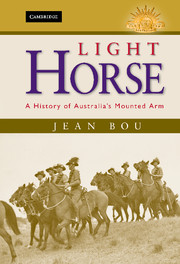Book contents
- Frontmatter
- CONTENTS
- List of maps
- ACKNOWLEDGEMENTS
- AUTHOR'S NOTE
- ABBREVIATIONS
- INTRODUCTION
- CHAPTER 1 ANCESTORS
- CHAPTER 2 TOUGH LESSONS
- CHAPTER 3 THE HUTTON ERA
- CHAPTER 4 UNFULFILLED PROMISE
- CHAPTER 5 THE LIGHT-HORSEMEN 1
- CHAPTER 6 MOUNTED RIFLES
- 7 CAVALRY
- CHAPTER 8 THE LIGHT-HORSEMEN 2
- CHAPTER 9 THE FINAL YEARS
- CONCLUSION
- EPILOGUE
- APPENDIX THE ‘BEERSHEBA CHARGE PHOTO’
- Notes
- BIBLIOGRAPHY
- INDEX
CHAPTER 5 - THE LIGHT-HORSEMEN 1
Citizen mounted troops and Australian society
Published online by Cambridge University Press: 05 July 2014
- Frontmatter
- CONTENTS
- List of maps
- ACKNOWLEDGEMENTS
- AUTHOR'S NOTE
- ABBREVIATIONS
- INTRODUCTION
- CHAPTER 1 ANCESTORS
- CHAPTER 2 TOUGH LESSONS
- CHAPTER 3 THE HUTTON ERA
- CHAPTER 4 UNFULFILLED PROMISE
- CHAPTER 5 THE LIGHT-HORSEMEN 1
- CHAPTER 6 MOUNTED RIFLES
- 7 CAVALRY
- CHAPTER 8 THE LIGHT-HORSEMEN 2
- CHAPTER 9 THE FINAL YEARS
- CONCLUSION
- EPILOGUE
- APPENDIX THE ‘BEERSHEBA CHARGE PHOTO’
- Notes
- BIBLIOGRAPHY
- INDEX
Summary
With the exception of the men who served during the First World War, the light-horsemen and their colonial predecessors were almost all part-time soldiers. Only the few permanent instructors and staff officers employed by the colonies, and later the Commonwealth, thought about and carried out their military duties as full-time professionals. Australian governments, shielded by the empire, facing no real threat, and loathe to raise and pay for any permanent forces apart from the small groups of technical troops who manned the guns of the forts or the submarine mines, were quite content with this. Only when the threat of Japan began to animate defence thinking after 1905 was a serious effort made to alter the way the country was defended, but even then under the universal training scheme the militia model was merely expanded rather than replaced and had only limited application to the mounted branch. By making these choices governments and their military commanders wedded themselves not just to a military training system but also to a complex interaction between the way their part-time soldiers trained to defend the country, then went home to lead normal and varied lives. To some extent armies are products of the society that begets them, and this is rarely more true than when considering the volunteer and partially paid men of the mounted forces of late colonial and post-Federation Australia.
The early volunteer mounted corps established around the Australian colonies between the 1850s and the mid-1880s had had a difficult time remaining viable organisations. Few of these bodies lasted long and, once the spurt of enthusiasm that had brought about their conception had spent itself, they usually collapsed under the weight of the problems that beset them. Uneven and poor standards of leadership, the financial strain of being a volunteer, negative attitudes from bystanders and repetitive or boring training all made their contribution to the high rates of discharge – and thus eventually corps failure – that characterised the early mounted units of the Australian colonies. After 1885 the larger mainland colonies adopted larger and more thorough plans to maintain their mounted forces and, with Federation, an even more complete plan was adopted.
- Type
- Chapter
- Information
- Light HorseA History of Australia's Mounted Arm, pp. 115 - 139Publisher: Cambridge University PressPrint publication year: 2009

